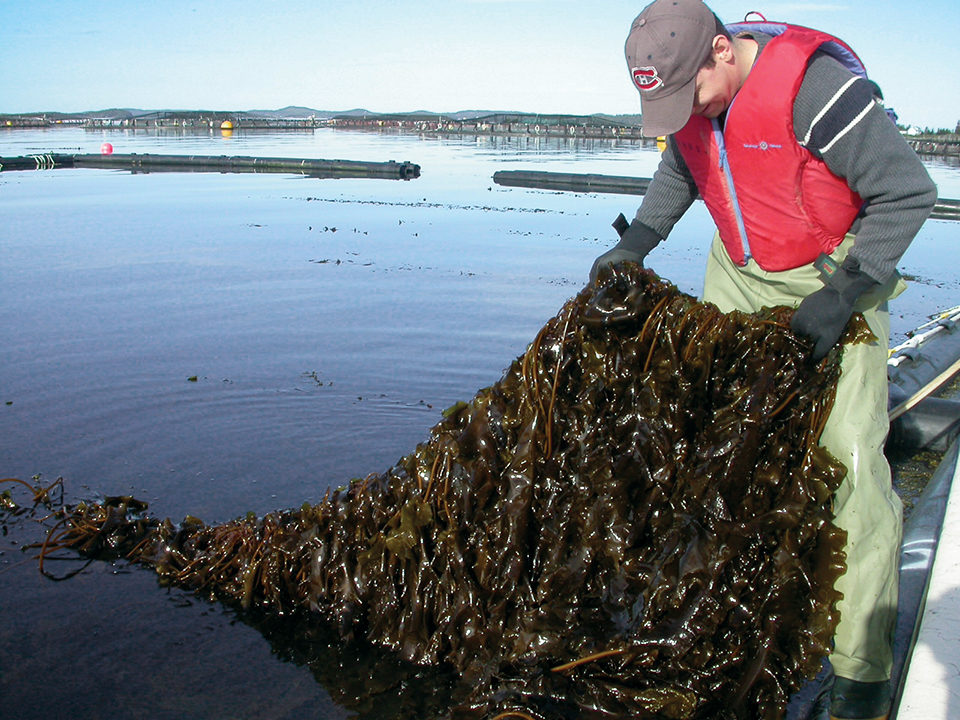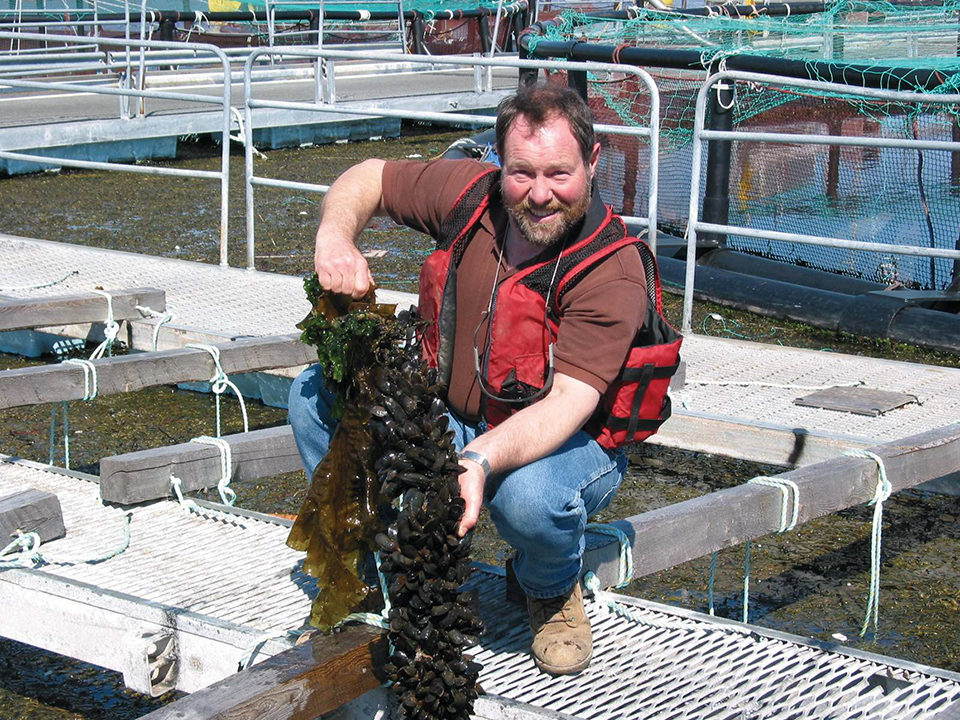Canadian project combines salmon, mussels, kelp

Worldwide expansion of Atlantic salmon (Salmo salar) farming has been rapid, with annual output exceeding 1.2 million metric tons (MT) and value over U.S. $4 billion in 2004. The industry growth is forecasted to continue into the future.
For independent farmers in a market that has become global and concentrated, and in locations where there is public participation in policy making, survival requires acquiring some competitive advantage while maintaining public support. Farms are under pressure to improve their economic performance with economies of scale while also enhancing the sustainable image of their industry. One option for salmon farmers to achieve these goals is to grow salmon with other species at the same site.
Integrated multitrophic aquaculture
Integrated multitrophic aquaculture (IMTA) systems combine fed aquaculture of fish with extractive inorganic aquaculture of seaweed and extractive organic aquaculture of shellfish. The approach is based on an age-old, common-sense recycling and farming practice: The byproduct wastes from one resource become inputs for another.
In Canada, an industrial pilot project is cultivating Saccharina latissima and Alaria esculenta kelps, blue mussels (Mytilus edulis) and Atlantic salmon in the Bay of Fundy. When compared to reference sites, growth rate increases of 46 percent for kelps and up to 50 percent for mussels cultured in close proximity to the fish farms reflect increases in food availability and energy.
Over six years, none of the therapeutants used in salmon aquaculture has been detected in the kelps and mussels collected from the IMTA sites, and levels of heavy metals, arsenic, polychlorinated biphenyls and pesticides have always been below regulatory limits. Biological results therefore support the establishment of IMTA systems.
Critical to the project is cooperation from two industrial partners: Cooke Aquaculture Inc. and Acadian Seaplants Limited. In addition, the Canadian Food Inspection Agency and Environment Canada are testing the kelps, mussels, and seawater to ensure that all products are suitable for public consumption.
Social sustainability
However, biological feasibility is not sufficient for a commercial operation to be sustainable. Sustainability also requires that economic and social criteria be met. An aquaculture operation must be economically viable without being too risky. In addition, attitudes of the public are important, because consumer perceptions influence the demand for and prices of products, and community attitudes affect the development of the sector.
Economic estimates with risk scenarios have been undertaken to compare the profitability of an IMTA system with salmon monoculture, and the public was surveyed for perceptions toward IMTA. It should be noted that all results are tentative, because the project only recently scaled up to a commercial operation.

Budgeting model
Initially a capital-budgeting mod-el was developed for a hypothetical salmon monoculture cage operation using parameters for the Bay of Fundy. To this were added fixed and operating costs for mussel and kelp cultivation, and potential additional revenues from these two species. Profitability was estimated by projections over 10 years using discount rates of 5 and 10 percent.
Since there is risk from disease and winter chill, it was imperative that a risk factor be added into the calculation of the financial ratios. Each of three IMTA scenarios was given a probability of occurrence.
Scenario 1 had salmon coming to harvest every second year and a mortality rate of 11 percent. This would give five successful harvests in the 10-year span with a probability of occurrence of 20 percent. Scenario 2 had only four successful harvests, with all fish assumed destroyed in one harvest. This scenario, which is plausible because of the potential effects of infectious salmon anaemia or winter chill, received a 40 percent probability. Finally, an intermediate scenario 3 had four successful harvests and one in which only 30 percent of the fish survived. This final scenario was also given a weighting of 40 percent.
Perception surveys
To study public attitudes toward IMTA, the authors adopted two methodologies. Initially in 2003, a random survey was undertaken in the Bay of Fundy region to determine attitudes toward general aquaculture before focusing on salmon monoculture and IMTA. Two study sessions were run in Charlotte County in southwestern New Brunswick.
A total of 165 participants responded from three populations. The response rate of 11.4 percent for the general public group of 110 was typical for survey research. A total of 53 respondents were from the 15 professional organizations and companies surveyed to date. Two respondents came from the two environmental organizations invited to participate.
Because many respondents were unaware of IMTA, a 12-minute video presentation was shown before focus groups were asked their opinions. The focus groups were differentiated according to interests. One was composed exclusively of “white table cloth” restaurateurs, another of the general public within the Bay of Fundy region, and the last a more geographically dispersed group of fish consumers. The aim of this second approach was to qualitatively gauge perceptions toward IMTA after informed discussion.
Model results
As Table 1 shows, additional revenues from mussels and seaweeds more than compensate for additional costs with a resulting 9.3 percent higher profitability for IMTA than salmon monoculture. As one would expect with diversification, IMTA results in higher profitability in all three scenarios of risk.
Mussels and seaweeds provide alternative sources of income, thereby softening the damaging effect of salmon losses. Just one bad harvest in which all fish are lost moves profitability toward zero on the entire 10-year run of a monoculture salmon farm, whereas with IMTA, it remains positive by an order of magnitude.
Rdler, Ten-year profitability, Table 1
| Operation | Scenario 1, Optimistic (Can $) | Scenario 2, Worst Case (Can $) | Scenario 3, Intermediate (Can $) |
|---|---|---|---|
| Salmon monoculture | 8,961,125 | 55,933 | 2,930,523 |
| IMTA | 9,797,078 | 742,038 | 3,625,641 |
Survey data
In addition, both the survey and focus groups indicated perceptions toward IMTA were more favorable than those toward salmon monoculture (Table 2). This was particularly encouraging because those most informed about the principles behind IMTA, the industry and environmental group representatives, were the most supportive.
Ridler, Survey responses, Table 2
| Response | General Public (102 Participants) | Aquaculture Industry (53 Participants) | Environmental Organizations (2 Participants) |
|---|---|---|---|
| Very positive | 12% | 36% | 50% |
| Positive | 46% | 38% | – |
| Neutral | 36% | 15% | 50% |
| Negative | 4% | 11% | – |
| Very negative | 2% | – | – |
Participants in the focus groups all linked success of aquaculture with sustainability. The groups emphasized that making a profit, raising quality products, and not harming the environment were all key to making the aquaculture industry successful and improving its public perception.
After watching the video, a majority of participants appeared skeptical or unsure if IMTA could reduce disease outbreaks, replenish natural stocks, or improve food quality (Table 3). However, most participants said IMTA has the potential to reduce the environmental impacts of salmon aquaculture, improve waste management, and benefit employment and community economies; and improve food production, industry competitiveness and sustainability. All felt that seafood produced in IMTA systems would be safe to eat, and 50 percent were willing to pay 10 percent more for these products, if they were labeled as such. The next step is a marketing study to identify whether ecolabeled products could bear the price premium.
Ridler, Post-video focus group, Table 3
| Do you think that IMTA has the potential for: | Yes (%) | Maybe/Not Sure (%) | No (%) |
|---|---|---|---|
| Reduce possible disease outbreaks? | 21.7 | 28.5 | 34.8 |
| Replenish natural stocks? | 22.7 | 22.7 | 54.6 |
| Improve food quality? | 31.8 | 40.9 | 27.3 |
| Reduce environmental impact of salmon farming? | 65.2 | 30.4 | 4.4 |
| Improve waste management in aquaculture? | 100.0 | 0 | 0 |
| Increase employment opportunities? | 90.9 | 9.1 | 0 |
| Improve community economies? | 95.5 | 4.5 | 0 |
| Increase food production? | 100.0 | 0 | 0 |
| Increase industry competitiveness? | 95.5 | 4.5 | 0 |
| Improve sustainability of aquaculture overall? | 72.7 | 27.3 | 0 |
(Editor’s Note: This article was originally published in the March/April 2007 print edition of the Global Aquaculture Advocate.)
Now that you've finished reading the article ...
… we hope you’ll consider supporting our mission to document the evolution of the global aquaculture industry and share our vast network of contributors’ expansive knowledge every week.
By becoming a Global Seafood Alliance member, you’re ensuring that all of the pre-competitive work we do through member benefits, resources and events can continue. Individual membership costs just $50 a year. GSA individual and corporate members receive complimentary access to a series of GOAL virtual events beginning in April. Join now.
Not a GSA member? Join us.
Authors
-
N. Ridler
University of New Brunswick
Centre for Coastal Studies and Aquaculture
Centre for Environmental and Molecular Algal Research
P. O. Box 5050
St. John, New Brunswick E2L 4L5 Canada[97,99,46,98,110,117,64,114,101,108,100,105,114]
-
K. Barrington
University of New Brunswick
Centre for Coastal Studies and Aquaculture
Centre for Environmental and Molecular Algal Research
P. O. Box 5050
St. John, New Brunswick E2L 4L5 Canada -
B. Robinson
University of New Brunswick
Centre for Coastal Studies and Aquaculture
Centre for Environmental and Molecular Algal Research
P. O. Box 5050
St. John, New Brunswick E2L 4L5 Canada -
M. Wowchuk
University of New Brunswick
Centre for Coastal Studies and Aquaculture
Centre for Environmental and Molecular Algal Research
P. O. Box 5050
St. John, New Brunswick E2L 4L5 Canada -
T. Chopin
University of New Brunswick
Centre for Coastal Studies and Aquaculture
Centre for Environmental and Molecular Algal Research
P. O. Box 5050
St. John, New Brunswick E2L 4L5 Canada -
S. Robinson
Department of Fisheries and Oceans
St. Andrews, New Brunswick, Canada -
F. Page
Department of Fisheries and Oceans
St. Andrews, New Brunswick, Canada -
G. Reid
Department of Fisheries and Oceans
St. Andrews, New Brunswick, Canada -
M. Szemerda
Cooke Aquaculture Inc.
St. George, New Brunswick, Canada -
J. Sewuster
Acadian Seaplants Limited
Dartmouth, Nova Scotia, Canada -
S. Boyne-Travis
Canadian Food Inspection Agency
St. George, New Brunswick, Canada
Tagged With
Related Posts

Responsibility
A look at integrated multi-trophic aquaculture
In integrated multi-trophic aquaculture, farmers combine the cultivation of fed species such as finfish or shrimp with extractive seaweeds, aquatic plants and shellfish and other invertebrates that recapture organic and inorganic particulate nutrients for their growth.

Responsibility
A look at various intensive shrimp farming systems in Asia
The impact of diseases led some Asian shrimp farming countries to develop biofloc and recirculation aquaculture system (RAS) production technologies. Treating incoming water for culture operations and wastewater treatment are biosecurity measures for disease prevention and control.

Intelligence
An overview of mussel culture in Chile
While Chile’s mussel industry has entered a growth phase, challenges remain, especially in the seed production and grow-out components. This contrasts with the well-developed nature of the country’s processing plants and marketing outlets.

Health & Welfare
Animal welfare: Growing factor in international aquaculture
Although concerns for the animal welfare of food animals are currently highest in the United Kingdom and European Union, they are also growing in other parts of the world.


